References
[1]. Glory, E. (2023). Supplier Relationship Management in the Era of Industry 4.0. European Journal of Supply Chain Management, 1(1), 41-51.
[2]. Obinna, N. (2024). Relationship between Supplier Relationship Management (SRM) Practices and Supply Chain Resilience. American Journal of Supply Chain Management, 9(1), 1-12.
[3]. Mohapatra, P., Tripathy, S., Dash, A. and Biswal, A. (2021). Supplier relationship management is a key to supply chain management. In Advances in Mechanical Processing and Design: Select Proceedings of ICAMPD 2019 (pp. 661-670). Springer Singapore.
[4]. O'Brien, J. (2022). Supplier relationship management: Unlocking the value in your supply base. Kogan Page Publishers.
[5]. Vaandrager, C. (2024). Optimizing risk mitigation in maritime supply chains through strategic supplier relationship management. Journal of Supply Chain Management Science, 5(1-2), pp.48-65.
[6]. Kayode, S. (2024). Supplier Relationship Management: Enhancing transparency, trust, and collaboration to identify and mitigate supply chain risks.
[7]. Grant, O. (2024). Exploring Transparency and Accountability in Supplier Relationship Management for E-Commerce.
[8]. Allal-Chérif, O., Simón-Moya, V. and Ballester, A.C.C.(2021). Intelligent purchasing: How artificial intelligence can redefine the purchasing function. Journal of Business Research, 124, pp.69-76.
[9]. Grant, O. (2024). Supplier Relationship Management in the Age of Digital Transformation: Insights from E-commerce Businesses.
[10]. Butollo, F.( 2021). Digitalization and the geographies of production: Towards reshoring or global fragmentation?. Competition & Change, 25(2), pp.259-278.
[11]. Brun, A., Karaosman, H. and Barresi, T.(2020). Supply chain collaboration for transparency. Sustainability, 12(11), p.4429
[12]. Timmer, M.P., Los, B., Stehrer, R. and de Vries, G.J. (2021). Supply chain fragmentation and the global trade elasticity: A new accounting framework. IMF Economic Review, 69(4), p.656.
[13]. Ihle, R., Rubin, O.D., Bar-Nahum, Z. and Jongeneel, R. (2020). Imperfect food markets in times of crisis: economic consequences of supply chain disruptions and fragmentation for local market power and urban vulnerability. Food Security, 12(4), pp.727-734.
[14]. Keohane, R.O. and Nye, J.S. (2020). Globalization: What's new? What's not?(And so what?). In Making policy happen (pp. 105-113). Routledge.
[15]. Green, C.L. (2022). Identifying Supplier Management Best Practices to Sustain Organization Resilience: A Systematic Review (Doctoral dissertation, University of Maryland University College).
[16]. Muchiri, D. (2022). Supply Chain Risk Management Strategies and Performance of Automotive Industry in Kenya During Covid-19 Pandemic (Doctoral dissertation, University of Nairobi).
[17]. Fröhlich, E. and Steinbiß, K.(2020). Supplier relationship management goes digital: first empirical insights. Universal journal of industrial and business management, 8(3), pp.63-73.
[18]. Chopra, S., & Meindl, P. (2010). Supply Chain Management: Strategy, Planning, and Operation. Prentice Hall
[19]. Hugos, M. H. (2006). Essentials of supply chain management (2nd ed.). Hoboken, NJ: John Wiley & Sons. https: //doi.org/10.1002/9781119204001
[20]. Han, Z., Handfield, R.B., Huo, B. and Tian, Y.( 2022). Effects of power use in buyer–supplier relationships: The moderating role of communication. Industrial Marketing Management, 102, pp.45-57.
[21]. Siemieniako, D., Makkonen, H. and Mitręga, M. (2023). Buying center-selling center interaction as a driver for power dynamics in buyer-supplier relationships. Industrial Marketing Management, 114, pp.94-109.
[22]. Johnsen, R.E., Lacoste, S. and Meehan, J. (2020). Hegemony in asymmetric customer-supplier relationships. Industrial Marketing Management, 87, pp.63-75.
[23]. Makkonen, H., Siemieniako, D. and Mitręga, M. (2023). Structural and behavioural power dynamics in buyer-supplier relationships: a perceptions-based framework and a research agenda. Technology Analysis & Strategic Management, 35(9), pp.1099-1113.
[24]. Siemieniako, D. and Kaliszewski, P. (2022). Factors influencing structural power dynamics in buyer-supplier relationships: a power sources framework and application of the critical incident technique. Oeconomia Copernicana, 13(1), pp.151-179.
[25]. Glavee-Geo, R., Engelseth, P. and Buvik, A.(2022). Power imbalance and the dark side of the captive agri-food supplier–buyer relationship. Journal of Business Ethics, 178(3), pp.609-628.
[26]. Bounlutay, A.(2024). Buyer-supplier relationship: Creating and managing relationship to build a competitive advantage.
[27]. Agarwal, U.A. and Narayana, S.A.(2020). Impact of relational communication on buyer–supplier relationship satisfaction: role of trust and commitment. Benchmarking: An International Journal, 27(8), pp.2459-2496.
[28]. Faruquee, M., Paulraj, A. and Irawan, C.A.( 2021). Strategic supplier relationships and supply chain resilience: is digital transformation that precludes trust beneficial?. International Journal of Operations & Production Management, 41(7), pp.1192-1219.
[29]. Gomes, L.D.C. ( 2022). Mitigation of Supply Chain Vulnerability Through Collaborative Planning, Forecasting, and Replenishment (CPFR). In Supply Chain Risk Mitigation: Strategies, Methods and Applications (pp. 95-119). Cham: Springer International Publishing.
[30]. Silva, P.M.P.F.D. (2023). Power in buyer-supplier relationships: multiple case studies in electronic retailing (Doctoral dissertation, Instituto Superior de Economia e Gestão).
[31]. Wildenborg, S.J.A. (2022). The effectiveness of power in supply chain relationships during times of scarcities (Bachelor's thesis, University of Twente).
[32]. Schwieterman, M.A., Miller, J., Knemeyer, A.M. and Croxton, K.L. (2020). Do supply chain exemplars have more or less dependent suppliers?. Journal of Business Logistics, 41(2), pp.149-173.
[33]. Roy, S.N. and Roy, S. (2024). Economies Of Scale In Retail Sectors-Lowering Cost And Assuring Competitive Price. Educational Administration: Theory and Practice, 30(4), pp.854-864.
[34]. Cleary, S. and McLarney, C.(2021). How Logistics Is Evolving: Why It Is Appropriate for Today and the Next Decade. IUP Journal of Supply Chain Management, 18(1).
[35]. Özcan, S. (2023). Dynamics of conflicts in multi-actor logistics service networks.
[36]. Bag, S., Choi, T.M., Rahman, M.S., Srivastava, G. and Singh, R.K.(2022). Examining collaborative buyer–supplier relationships and social sustainability in the “new normal” era: The moderating effects of justice and big data analytical intelligence. Annals of operations research, pp.1-46.
[37]. Adesanya, A., Yang, B., Bin Iqdara, F.W. and Yang, Y., (2020). Improving sustainability performance through supplier relationship management in the tobacco industry. Supply Chain Management: An International Journal, 25(4), pp.413-426.
[38]. Schirnhofer, N.M. (2022). Sustainability efforts in the retail industry: the case study of walmart (Master's thesis, Webster University).



